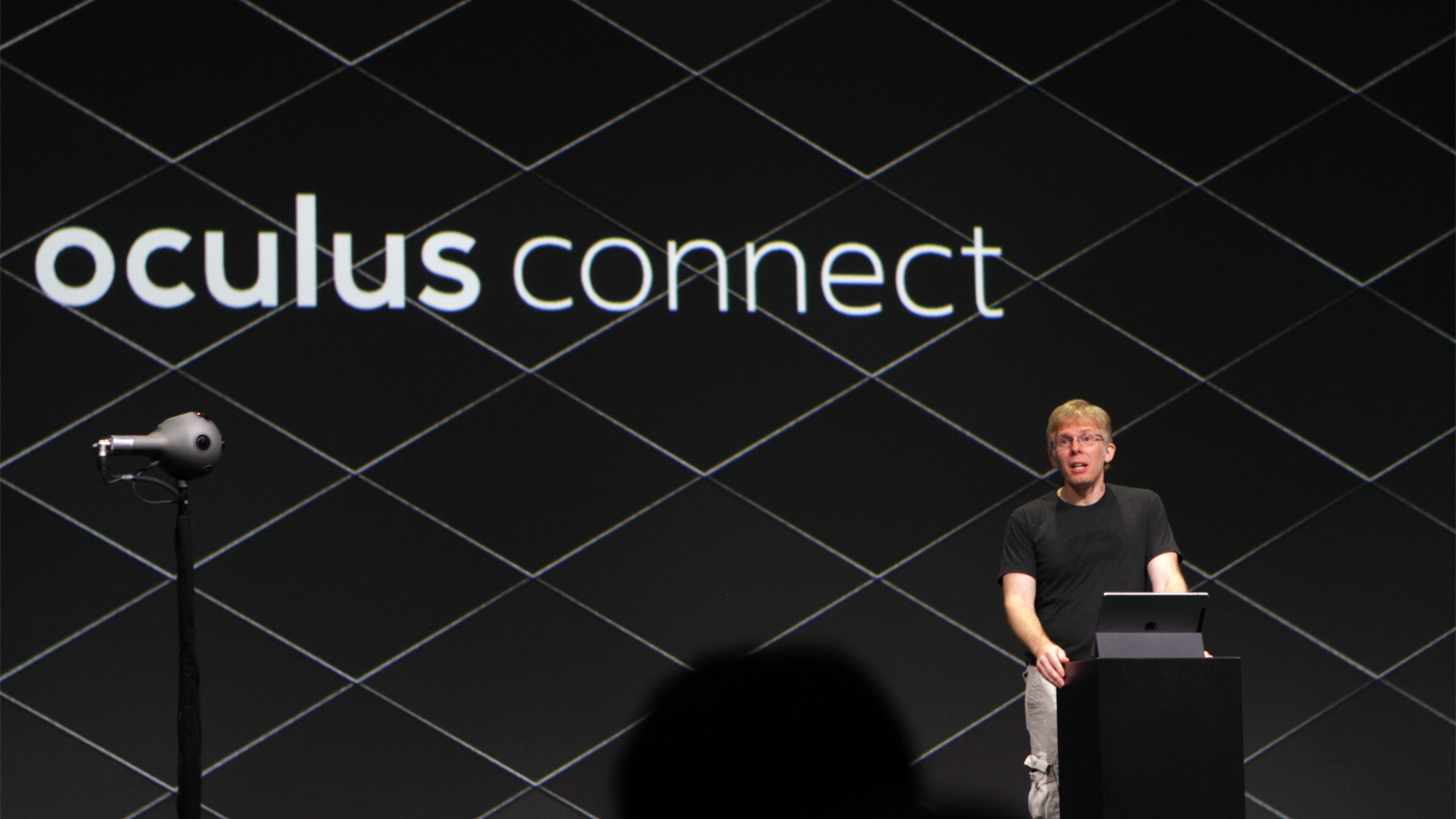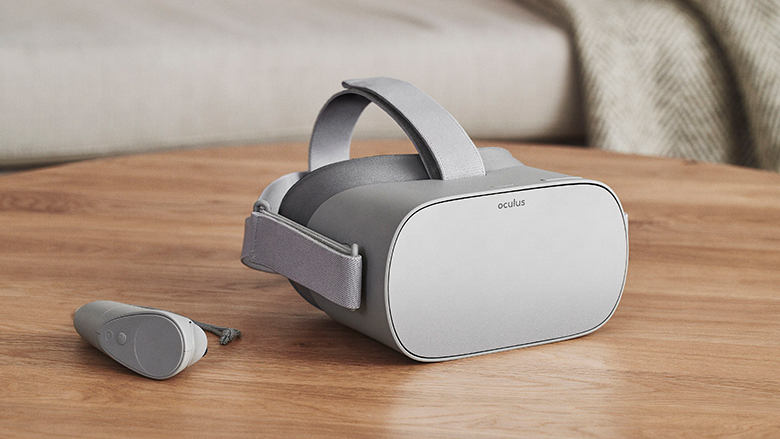Why Oculus Go?

The biggest hardware product announcement at the Oculus Connect conference this year was the company’s first untethered standalone VR headset, the Oculus Go. On paper, it doesn’t represent a major performance breakthrough, with its previous-gen mobile SoC and its 3DoF tracking. Instead, Oculus is pricing and positioning this new HMD as a critical building block in VR’s next critical journey: mass adoption.
For most of the world, Oculus CTO John Carmack said during his annual talk at the conference, their first impression of VR is still ahead of them, and the task at hand is lowering the barriers to trying it out.
Instead of doubling down on high-end hardware, Oculus has made an HMD that is more affordable and comparatively frictionless when viewed alongside the (also) untethered Samsung Gear VR as well as the Oculus Rift. And now that its target specs are known and predictable, performance optimization becomes easier for Oculus and its developers--similar to gaming consoles.
Removing Friction From VR Adoption
Because Oculus Go is self-contained, it offers progress along several fronts.
You don’t have to buy or have a high-end phone like you do with Samsung Gear VR or Google Daydream View. You don’t have to manually put a phone into the HMD in order to get started.The Oculus software doesn’t have to coexist with an Android OS that has been “optimized” by both carrier and phone manufacturer to house non-VR applications and services that consume precious processing, memory, and storage resources.
The total Go package cost is $199, which gives this announcement a surprising twist. Even if you have one of the smartphones supported for use with Gear VR or Daydream, that price is a little shocking given that even cheap Snapdragon 821 smartphones run $399 and up. If you don’t own one of those smartphones, $199 is tempting by itself. It’s even “giftable” for those with moderately high incomes, according to Carmack.
Getting The Little Things Right
Oculus is very much aware that the shine of VR has worn off. We are out of the heroic age of VR, Carmack proclaimed, adding that the big bolt of lightning isn’t going to happen, and that now is the time for the hard work that will drive mass adoption.
Stay On the Cutting Edge: Get the Tom's Hardware Newsletter
Get Tom's Hardware's best news and in-depth reviews, straight to your inbox.
“All of the ingredients we need are here, they’re just not stirred, cooked, and seasoned like they need to be yet,” he said. Carmack’s two-hour talk, which later spilled out into the hallways of Oculus Connect as it often does, concentrated on outlining the painstaking and careful work the VR industry needs to do to improve what we already have, from very basic clean up of the user experience to more disciplined coding of VR applications. He encouraged developers to continue to improve the value they were providing customers, to “embrace the grind” and have “more ‘give a damn’” in getting “a thousand little things right.”
Carmack takes that message personally, and it’s clear he drives it home inside the walls of Oculus, where he said the company is diligently working on getting those little things right, including focusing on making sure devices don’t overheat, lenses don’t fog, and that images don’t produce glare and ghosting.
And all of that is sort of the point with Oculus Go. To hear Carmack talk, there’s plenty of performance headroom left to exploit.

Oculus Go And The “Net” Wins
Go makes plenty of compromises—what Carmack calls “net wins” rather than “pure wins.” Tradeoffs, in other words, where “magic software” trumps “magic hardware.”
One of those net wins is the Go’s LCD display. For years, Oculus has touted the benefits of OLED (see: Rift and Gear VR), with its perfect blacks, pure colors, and superior response time. But there are downsides. The Rift has to make up for OLED pixel inconsistencies using Mura correction, which introduces processing overhead that’s difficult for mobile processors to handle. Similarly, he pointed to ghosting issues on the Gear VR, and other artifacts that the PC-powered Rift can adjust to (using software overdrive and other techniques).
On the other hand, LCDs provide more sub pixels, which, among other benefits, helps lessen the screen door effect. But LCDs negatively impact latency. In order to reduce the Gear VR’s latency, Oculus makes use of a rolling shutter, also known as “chasing the raster” or “chasing the beam” (explained at length by now-Oculus chief scientist Michael Abrash in a seminal paper back in 2013 called Raster-Scan Displays: More Than Meets The Eye). Put simply, it involves lighting up the screen and drawing pixels as closely as possible behind the light.
The LCD panel in the Oculus Go makes use of a global shutter effect (also used in the Rift), where all of the values are changed with the backlight turned off, followed by a big blast of the backlight. It adds latency, some of which can be fixed using late latch techniques in the Oculus time warp (essentially a step where textures are warped on the display, using the very latest head tracking information, and transformed to account for lens distortion— read more here for a deeper description of time warp). Naturally, it’s easier for a PC to overcome this latency penalty.
The Go also has newer Fresnel lenses. Many users notice Fresnel glare on the Rift using the original lenses. Also, on Gear VR, the lenses make everything on the periphery look fairly blurry. These issues have been largely addressed with the Go lenses.
Audio has also improved over Gear VR, where the friction of adding headphones and accidentally undocking the phone prevents most people from using them. We don’t particularly find the Rift flip-down speakers to be a bad experience, but Carmack said he finds them a bit awkward. In Oculus Go, the drivers are inside main headset, and piped through the first part of straps. We found these vastly improved in our hands-on with the forthcoming (and also untethered, standalone) Santa Cruz HMD..
With Go, Oculus gets to remove some of the barriers presented by the number of players in the mobile VR ecosystem—meaning Samsung and the cellular carrier. Although those players offer a huge marketing and distribution boost for VR, Oculus loses control of the user experience, including the nightmare of updates every time you go to use Gear VR. Now, any work Oculus does on driver updates and advances leveraging the Qualcomm SoC can happen more frequently and more timely.
Multi-View, also known as single-pass rendering—a technique that significantly conserves processing overhead—took three years to accomplish because of these multi-player supply chain issues, according to Carmack. In the PC space, he said, an extension like that would take a week to work out with Nvidia and AMD, and then only a couple of months to roll out to end users. Right now, he said, Oculus is working with Qualcomm on a foveated rendering extension that will bypass the painful approval processes of yesteryear. Oculus will enable it transparently in applications.
Finally, everything that Oculus can make successful on Go will ultimately also become easier to implement on Gear VR. Carmack said that he believes the mobile drop-in model (i.e., Gear VR) will still garner the largest number of users, even if Go is successful, and the ultimate idea is to make VR possible on $50 smartphones.
Viability?
Further details are beyond the scope of this article, but we talked to other developers similarly convinced that standalone VR doesn’t impose insurmountable challenges. We also attended sessions where developers were provided with new tools and techniques to optimize mobile VR experiences and improve performance, including some nifty ideas for reducing draw calls using the Unity engine for mobile development, for example.
One unsettling bit: We didn’t get our hands on Oculus Go. Developer kits are coming next month, and we’ll be sure to provide our insights once we have a review unit.
-
Jagwired Oculus Go is my dream come true. I've been holding off on VR because I don't want to run wires all around my room. I also don't want to flip my phone in and out of a VR headset whenever I want to use it. I like that the Go gives VR developers a well defined spec too. It's almost like a game console.Reply -
Sakkura They are setting up an awesome future. Imagine a $199 headset with more powerful hardware, along with a bigger content library with higher quality.Reply
That will be the Go 2 headset in a year or two. ;) -
cryoburner Reply20285583 said:At $200, this is tempting. Becoming a lot easier to justify it as a 3rd monitor.
It's not really like a monitor though. Oculus Go is a standalone device, more like a phone or handheld game machine. From what I can tell, you won't be able to hook it up to a computer, and are limited to the performance of the built in mobile hardware it ships with. Plus it only does 3DoF tracking. It basically has the same VR functionality as a mid-range smartphone in a plastic shell, and runs the same mobile software.
PC connectivity would be a feature I would want to see in a device like this though. I don't see much reason why they couldn't add the option to connect a tether for PC VR without increasing the cost much. And for that matter, if they can sell a device like this for $199, it seems like it wouldn't cost much more than $100 to include standalone mobile VR functionality in higher-end PC VR headsets. We'll likely see these standalone and tethered devices merging soon enough. -
bit_user Reply
Aren't you the least bit concerned about 3-DoF?20284840 said:Oculus Go is my dream come true. I've been holding off on VR because I don't want to run wires all around my room. I also don't want to flip my phone in and out of a VR headset whenever I want to use it. I like that the Go gives VR developers a well defined spec too. It's almost like a game console.
All of the advantages you cited are also true of their "Project Santa Cruz" HMD. I recommend you get that, instead.
-
Sakkura Reply20286406 said:Aren't you the least bit concerned about 3-DoF?
All of the advantages you cited are also true of their "Project Santa Cruz" HMD. I recommend you get that, instead.
Launch of the Santa Cruz headset has not been confirmed yet. But yeah... 6 DOF tracking, of both headset and controllers, is a big deal.
